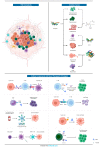Decipher the Glioblastoma Microenvironment: The First Milestone for New Groundbreaking Therapeutic Strategies
- PMID: 33804731
- PMCID: PMC8003887
- DOI: 10.3390/genes12030445
Decipher the Glioblastoma Microenvironment: The First Milestone for New Groundbreaking Therapeutic Strategies
Abstract
Glioblastoma (GBM) is the most common primary malignant brain tumour in adults. Despite the combination of novel therapeutical approaches, it remains a deadly malignancy with an abysmal prognosis. GBM is a polymorphic tumour from both molecular and histological points of view. It consists of different malignant cells and various stromal cells, contributing to tumour initiation, progression, and treatment response. GBM's microenvironment is multifaceted and is made up of soluble factors, extracellular matrix components, tissue-resident cell types (e.g., neurons, astrocytes, endothelial cells, pericytes, and fibroblasts) together with resident (e.g., microglia) or recruited (e.g., bone marrow-derived macrophages) immune cells. These latter constitute the so-called immune microenvironment, accounting for a substantial GBM's tumour volume. Despite the abundance of immune cells, an intense state of tumour immunosuppression is promoted and developed; this represents the significant challenge for cancer cells' immune-mediated destruction. Though literature data suggest that distinct GBM's subtypes harbour differences in their microenvironment, its role in treatment response remains obscure. However, an in-depth investigation of GBM's microenvironment may lead to novel therapeutic opportunities to improve patients' outcomes. This review will elucidate the GBM's microenvironment composition, highlighting the current state of the art in immunotherapy approaches. We will focus on novel strategies of active and passive immunotherapies, including vaccination, gene therapy, checkpoint blockade, and adoptive T-cell therapies.
Keywords: cancer stem-cells; glioblastoma; immunotherapy; tumour microenvironment.
Conflict of interest statement
The authors declare no conflict of interest.
Figures

Similar articles
-
The N6-Methyladenosine-Modified Pseudogene HSPA7 Correlates With the Tumor Microenvironment and Predicts the Response to Immune Checkpoint Therapy in Glioblastoma.Front Immunol. 2021 Jul 20;12:653711. doi: 10.3389/fimmu.2021.653711. eCollection 2021. Front Immunol. 2021. PMID: 34354698 Free PMC article.
-
Glioblastoma Microenvironment and Invasiveness: New Insights and Therapeutic Targets.Int J Mol Sci. 2023 Apr 11;24(8):7047. doi: 10.3390/ijms24087047. Int J Mol Sci. 2023. PMID: 37108208 Free PMC article. Review.
-
Neuroinflammation in Glioblastoma: The Role of the Microenvironment in Tumour Progression.Curr Cancer Drug Targets. 2024;24(6):579-594. doi: 10.2174/0115680096265849231031101449. Curr Cancer Drug Targets. 2024. PMID: 38310461 Review.
-
Astrocytes, the rising stars of the glioblastoma microenvironment.Glia. 2019 May;67(5):779-790. doi: 10.1002/glia.23520. Epub 2018 Sep 21. Glia. 2019. PMID: 30240060 Review.
-
Local Targeting of NAD+ Salvage Pathway Alters the Immune Tumor Microenvironment and Enhances Checkpoint Immunotherapy in Glioblastoma.Cancer Res. 2020 Nov 15;80(22):5024-5034. doi: 10.1158/0008-5472.CAN-20-1094. Epub 2020 Sep 30. Cancer Res. 2020. PMID: 32998997 Free PMC article.
Cited by
-
Prognosis of Oligodendroglioma Patients Stratified by Age: A SEER Population-Based Analysis.Int J Gen Med. 2021 Dec 9;14:9523-9536. doi: 10.2147/IJGM.S337227. eCollection 2021. Int J Gen Med. 2021. PMID: 34916834 Free PMC article.
-
Current state of immune checkpoints therapy for glioblastoma.Heliyon. 2024 Jan 13;10(2):e24729. doi: 10.1016/j.heliyon.2024.e24729. eCollection 2024 Jan 30. Heliyon. 2024. PMID: 38298707 Free PMC article. Review.
-
Innovating Strategies and Tailored Approaches in Neuro-Oncology.Cancers (Basel). 2022 Feb 22;14(5):1124. doi: 10.3390/cancers14051124. Cancers (Basel). 2022. PMID: 35267432 Free PMC article. Review.
-
Glioblastoma Therapy: Past, Present and Future.Int J Mol Sci. 2024 Feb 21;25(5):2529. doi: 10.3390/ijms25052529. Int J Mol Sci. 2024. PMID: 38473776 Free PMC article. Review.
-
Old and New Systemic Immune-Inflammation Indexes Are Associated with Overall Survival of Glioblastoma Patients Treated with Radio-Chemotherapy.Genes (Basel). 2022 Jun 13;13(6):1054. doi: 10.3390/genes13061054. Genes (Basel). 2022. PMID: 35741816 Free PMC article.
References
Publication types
MeSH terms
LinkOut - more resources
Full Text Sources
Other Literature Sources
Medical

